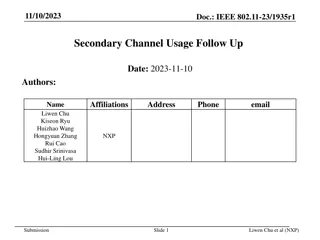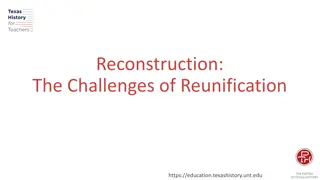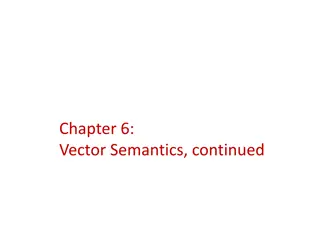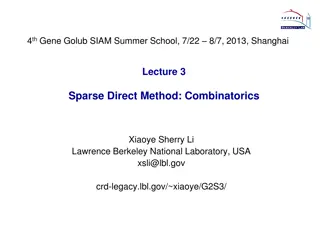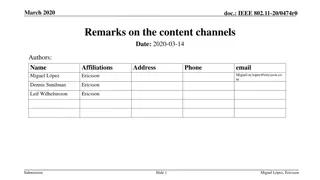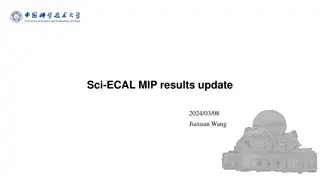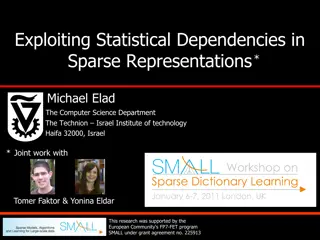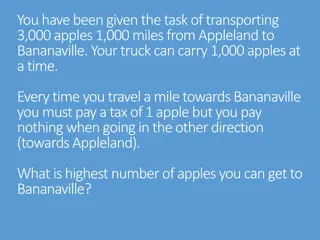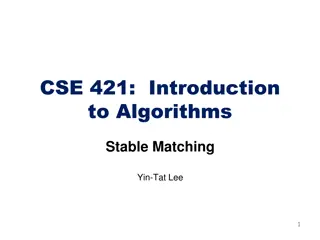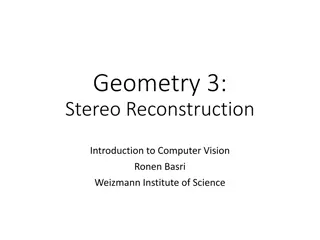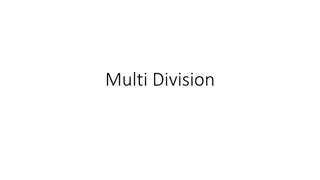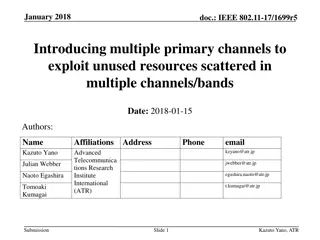
Dynamic Sparse Channel Reconstruction through Matching Pursuit
Learn about the Structured Matching Pursuit method for reconstructing dynamic sparse channels efficiently utilizing compressive sensing algorithms such as Orthogonal Matching Pursuit (OMP) and Compressive Sampling Matching Pursuit (CoSaMP). Explore the system model, temporal correlation of dynamic channels, and the key idea for effective channel taps detection in this informative presentation.
Download Presentation

Please find below an Image/Link to download the presentation.
The content on the website is provided AS IS for your information and personal use only. It may not be sold, licensed, or shared on other websites without obtaining consent from the author. If you encounter any issues during the download, it is possible that the publisher has removed the file from their server.
You are allowed to download the files provided on this website for personal or commercial use, subject to the condition that they are used lawfully. All files are the property of their respective owners.
The content on the website is provided AS IS for your information and personal use only. It may not be sold, licensed, or shared on other websites without obtaining consent from the author.
E N D
Presentation Transcript
Structured Matching Pursuit for Reconstruction of Dynamic Sparse Channels Presenter: Xudong Zhu Authors: Xudong Zhu, etc. Tsinghua University, Beijing, China
Background Channel state information (CSI) Training sequences are usually utilized for channel estimation Overhead of training sequences reduces spectrum efficiency Compressive sensing (CS) CS is able to recover channel from much less measurements CS can be utilized to reduce the length of training sequences Various CS algorithms OMP: Orthogonal matching pursuit CoSaMP: Compressive sampling matching pursuit SOMP: Simultaneous OMP
System Model Channel estimation based on training sequence ?(?)= ??(?)+ ?(?),? = 1,2, ,?, ? ?,?2 ?, ,?? ? ?(?)= ?1 denotes the linear measurement; ? ?, 2 ?, , ? ? ?(?)= 1 ? ? ?is a Toeplitz matrix based on ? = ?0,?1, ,?? ?(?) ?? ?,?? denotes the channel vector, ? > ?; ?; 2??.
Temporal correlation of dynamic channels Common path delay set com= {?:? ?,? = 1,2, ,?}, ? 0} denotes the path delay set of ?(?); (?)= {?:? ,?? = {1,2, ,?} denotes the entire set; com = ? ? denotes the size of the common path delay set; ? denotes the temporal correlation degree of dynamic sparse channels.
Dynamic Channel Model 1.4 Dynamic Sparse Channel in Time slot 1 Dynamic Sparse Channel in Time slot 2 Dynamic Sparse Channel in Time slot 3 Dynamic Sparse Channel in Time slot 4 1.2 1 common channel taps 0.8 Path Gain dynamic channel taps 0.6 0.4 0.2 0 0 20 40 60 80 Path Delay 100 120 140 160 180 Fig1. Illustration of the dynamic Vehicular B channel.
Key idea Common channel taps detection A series of received measurements can be utilized to improve the detection performance of common channel taps Common channel taps estimation can be utilized for initialization for channel estimation for any specific time slot to reduce computational complexity Dynamical channel taps detection Before detecting dynamical channel taps, common channel taps have been already detected Dynamical channel taps are added to replace the wrong channel taps in the common channel taps set
Common channel taps detection Received measurement: ? = [?1,?2, ,?(?)]; 1. Correlation operator: ? = ???; 2. Common support detection: ?0= argmax 3. Common support set update: com= com ?0; 4. Residual signal update: ? = ? ? com? com Repeat step 1~4 for ? times. ?|??,?|; ? ?;
Dynamic channel taps tracking At ?-th time slot: ?(?)= ? com 1. Dynamic channel tap tracking: ?0= argmax ?(?), ? = ?(?) ? ?(?), ?= com; ??; ?? ? 2. Channel estimation update: (?)= (?) ?0, ??= ? ? 3. Channel taps set update: (?)= {? largest indices in ?(?)}; 4. Residual signal update: ? = ? ? ? ? ? Repeat step 1~4 until (?)is unchanged in step 2 and 3. ?(?); ?(?);
Simulation Setting ? = 200,? = 100; (?) ? 0,1 , ? (?); Delays of dynamical channel taps are randomly chosen from \ com; ? = 10: coherence time of dynamical sparse channel; SNR 10,30 dB of the received measurements; 1 ? ?: temporal correlation. ?
Simulation Counterparts: Linear method: ?(?)= ? ?(?); OMP: Simple CS method for each time slot; SP: Improved CS method for each time slot; A-SOMP: Improved CS method for several correlated time slots; Oracle LS: Theoretical bound by assuming perfect knowledge of path delay set (?).
Simulation result (1) 1 0.9 0.8 Correct Detection Probability 0.7 0.6 0.5 Commmon Channel Taps Detection ( =4) Commmon Channel Taps Detection ( =6) Commmon Channel Taps Detection ( =8) Commmon Channel Taps Detection ( =10) 0.4 -10 -8 -6 -4 -2 0 2 4 6 8 10 SNR (dB) Fig. 2. Correct detection probability of the common channel taps against SNR.
Simulation result (1) 0 10 MSE -1 10 Linear Method [4] OMP [7] SP [10] A-SOMP [14] Proposed SMP Oracle-LS [23] -2 10 1 2 3 4 5 6 7 8 9 10 Temporal correlation degree L Fig3. MSE performance comparison against the temporal correlation ? with SNR=5 dB.
Simulation result (3) 0 10 Linear Method [4] OMP [7] SP [10] A-SOMP [14] Proposed SMP Oracle-LS [23] -1 10 MSE -2 10 -3 10 -4 10 5 10 15 20 25 30 SNR (dB) Fig. 4. MSE performance comparison against SNR for different reconstruction algorithms with ? = 5.


